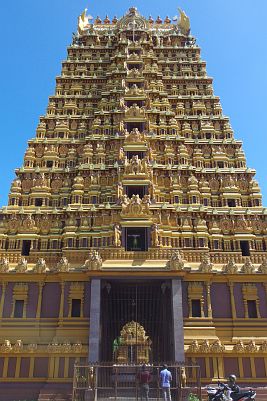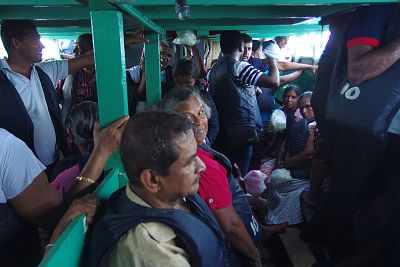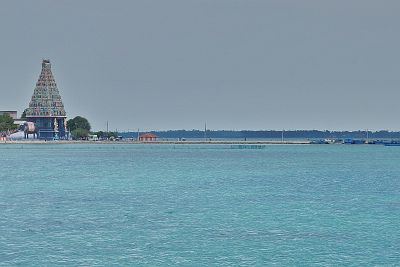Jaffna Town and Islands
(vero;2018-Oct-13)
We have selected some pictures for our photo gallery dedicated to the Jaffna Peninsula.
 We took the train from Anuradhapura to Jaffna, a pleasant ride, very shaky at the beginning but we could tell that the rail infrastructure in the North has improved as the ride got smoother the further north we came, with new brimming stations along the way. The rain started to fall on cue just as we passed Elephant Pass, the causeway linking the peninsula to the rest of Sri Lanka. We felt a bit cheated: it was not supposed to rain in this part of the country, or so we thought!
We took the train from Anuradhapura to Jaffna, a pleasant ride, very shaky at the beginning but we could tell that the rail infrastructure in the North has improved as the ride got smoother the further north we came, with new brimming stations along the way. The rain started to fall on cue just as we passed Elephant Pass, the causeway linking the peninsula to the rest of Sri Lanka. We felt a bit cheated: it was not supposed to rain in this part of the country, or so we thought!
We went in search of a hotel under the rain and eventually stayed at Skylight Guest Inn where we paid 1500 Rs for a room with attached bathroom. The place overlooked a quite busy crossroad but since there was hardly any traffic at night this was not an issue. In the contrary, we had a balcony where we could sit and watch life going on in the neighbourhood.
We liked Jaffna: it was at last a real town with a market, some shops and many good cheap eateries. But we soon realised that apart from the very city centre, there is not a lot to do. We visited the city on our first full day, dutifully stopping at all landmarks mentioned in our guidebook. We found the remains of old Jaffna Kingdom underwhelming, the fort was empty everything inside having been destroyed during the civil war, the public library was open for members only, which means that apart from the churches and the big Hindu temple where we spent much time people watching there was nothing really exciting to see.
Leafy residential areas start as soon as one leaves the compact city centre and nothing happens there: people are simply home. No business life, no workshops or local shops. The avenues are lined with bungalows and every so often one can see evidence of the war: here a heap of rubbles or a ruined house, there a gap and a wild garden where a house once stood.
Nevertheless we found Jaffna quite engaging. For the first time in Sri Lanka we did notice the noise of honking vehicles. Only few people have their own cars, but there were plenty of busses, lorries, vans, pickups, motorbikes or bicycles plying the roads.
We spent our second full day touring the islands west of the peninsula. The scenery was nothing spectacular, the land was flat and dry, scattered with depressing settlements. Many houses we saw were empty and half ruined: rural migration? civil war ruins? probably a combination of both. But in spite of this we really enjoyed the outing. Driving along the causeways connecting the islands gave a feeling of space and the lagoon and the many birds made for a great background.
But it was not all smooth cruising: our itinerary included two ferry crossings and the first one from Kurikadduwan to Nainativu was quite a hair raising experience.
How often had we heard stories on the News about the human tragedy of a ferry having capsized in some developing country with most of the passengers drowned? We always wondered how it was possible that hardly anybody survived: couldn't they swim at all? Well, that's exactly what came to our minds when we finally boarded this ferry and found ourselves under deck packed with our fellow passengers in a confined space. There were no windows, only slits hardly wide enough to let a person escape and to top it all, access to the upper deck was only via two rickety and steep ladders. We were “parked” quite far away from the ladders and looked at each other knowing that we were both thinking the unthinkable, imagining the catastrophe unfolding if the boat was ever to sink: people rushing to the ladders, crushing each other, there would be no way to escape in the ensuing panic.
 We preferred not to think about it, it would be really bad luck indeed if this very ferry was to sink today! Looking around us, we could not repress a smile as we noticed the small altar set-up under the prow. It featured an assortment of deities, even Jesus was there, at least we would die in good company!
We preferred not to think about it, it would be really bad luck indeed if this very ferry was to sink today! Looking around us, we could not repress a smile as we noticed the small altar set-up under the prow. It featured an assortment of deities, even Jesus was there, at least we would die in good company!
Of course and luckily nothing of the sort happened, however we made a point on the return trip to be the last boarding the ferry and we spent the crossing on the deck in the open air which was quite a relief!
The second ferry crossing from Kayts to the island of Karaitivu was very short and pure bliss in comparison: the boat was a simple platform with an outboard engine, sliding along an immersed cable. Very reassuring!
We left Jaffna for Colombo with the morning train which was already quite full on arrival. We were lucky to get two aisle seats facing each other; many people had to stand in the corridor and it got worse when we stopped in Anuradhapura. From there on, the train felt very much like a crowded commuter train in the rush hour (we were travelling in 3rd class).
Jaffna Islands — Practicalities: Bus Jaffna - Kurikadduwan (KKD) = 80 Rs — Ferry KKD - Nainativu - KKD = 30 Rs — Bus KKD - Velanai = 45 Rs - Bus Valanai - Kayts = 17 Rs - Ferry Kayts - Karaitivu = free - Bus Karaitivu - Jaffna = 45 Rs. All prices are per person.
We have selected some pictures for our photo gallery dedicated to the Jaffna Peninsula.
Want to read more? Go back to State of Emergency in Kandy or go on to Lizards and Other Creatures or go up to Blog
$ updated from: Blog.htxt Mon 28 Apr 2025 14:55:28 trvl2 — Copyright © 2025 Vero and Thomas Lauer unless otherwise stated | All rights reserved $



